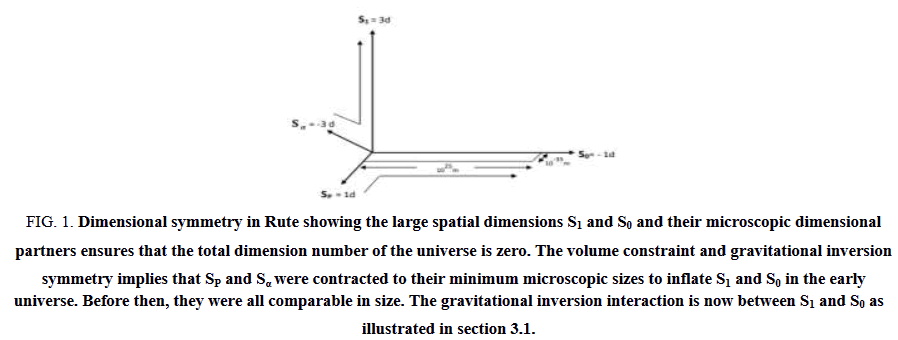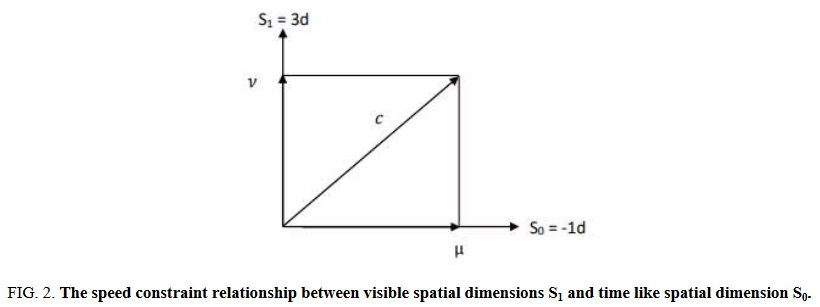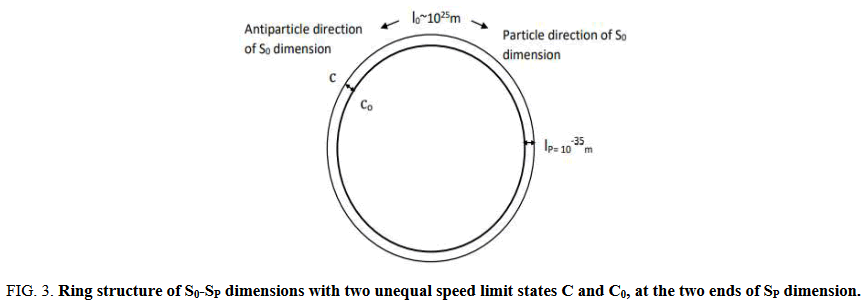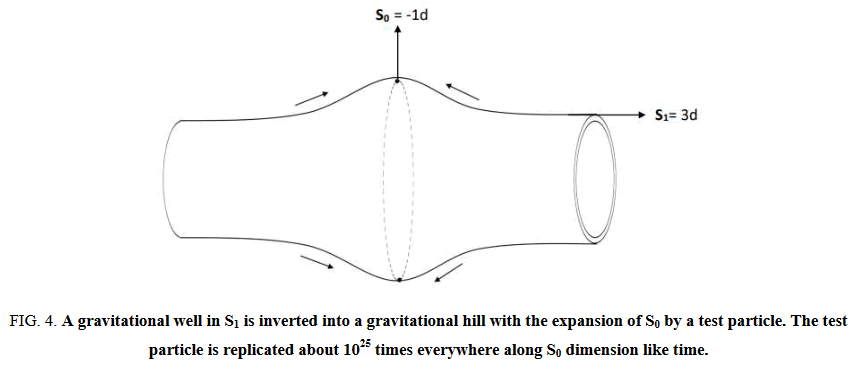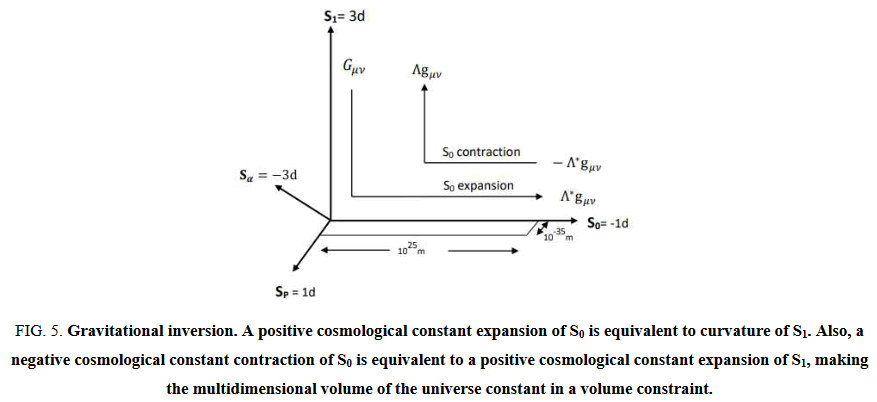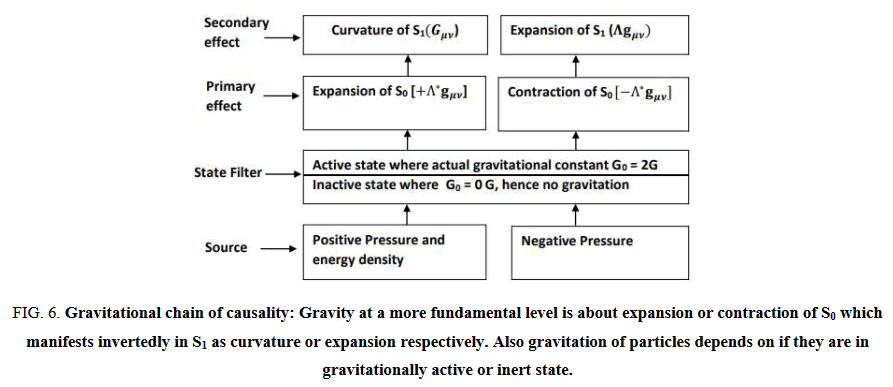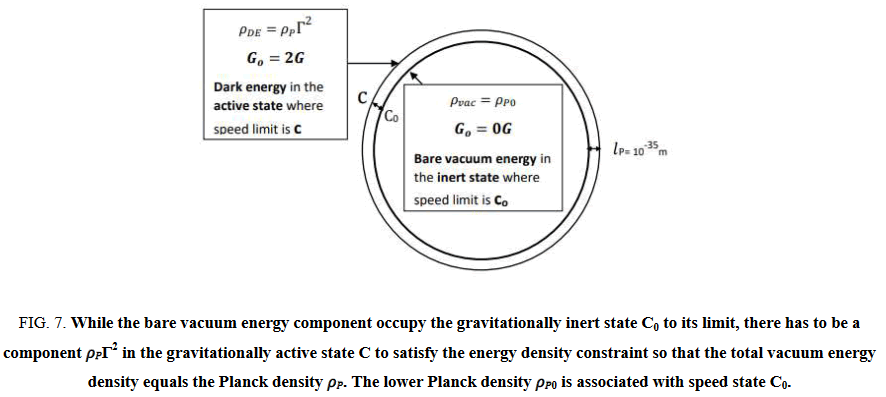Research
, Volume: 12( 9) DOI: 10.37532/2320-6756.2023.11(9).379Unified Dark Energy and Dark Matter from Rute as Different Manifestations of Vacuum Energy
- *Correspondence:
- Kabir A. Umar
Department of Physics and Astronomy, University of Abuja, Abuja, Nigeria
E-mail: kabir_umar@yahoo.com
Received date: Sept 01, 2024, Manuscript No. TSPA-24-152348; Editor assigned: Sept 05, 2024, Pre-QC No. TSPA-24-152348 (PQ); Reviewed: Sept 19, 2024, QC No. TSPA-24-152348 (Q); Revised: Sept 21, 2024, Manuscript No. TSPA-24-152348 (R); Published: Sept 27, 2024, DOI. 10.37532/2320-6756.2024.11(9).379
Citation: Umar AK, Benjamin GA. Unified Dark Energy and Dark Matter from Rute as Different Manifestations of Vacuum Energy. J. Phys. Astron.2023;11 (9):379.
Abstract
Dark energy and dark matter are both described as different manifestations of vacuum energy within the framework of Rute. It describes gravitational inversion in a dimensional symmetry and interactions regulated by constraints. In this framework, the bare vacuum energy component exists in a gravitationally inert state where actual gravitational constant Go=0G, while real particles oscillates between this inert state and the active state where Go=2G. The background effect of neutrino substrates in the inert state makes Go>0G in such state, causing the gravitation of virtual particles with positive pressure appearing as hot and cold dark matter. A non-zero component of vacuum energy also spills into the gravitationally active state as a cosmological constant form of dark energy. This is due to an energy density constraint and speed limit asymmetry between the two gravitational states that limits the capacity of the inert state to contain the entire vacuum energy component. This form of dark energy and dark matter, are both parameterized by a common asymmetry parameter Γ which is suppressed in deep gravitational potential wells. Rute predicts a testable Gravitational Wave Reheating (GWR) mechanism in which gravitational waves produce electromagnetic secondaries in the presence of negative pressure such as that from strong magnetic fields and even dark energy. This mechanism which may explain Fast Radio Bursts (FRBs) and Excess Radio Background (ERB) is also suppressed by the positive curvature of deep gravitational wells.
Keywords
Rute; Gravitational Inversion; Constraints; Cosmological Constant; Dark; Energy; Dark Matter; Neutrino Substrate; Speed Limit Asymmetry; Energy; Density Constraint; Gravitational Wave Reheating
Introduction
Dark energy has remained a mystery since its first discovery in 1998 [1,2]. Several independent observations including the Planck data indicates that dark energy constitutes about 68.3% of the total energy budget of the universe and driving its accelerated expansion [3]. This is in addition to the existing mystery of dark matter which appears to be some invisible but gravitating form of matter that clusters within and around galaxies. Dark matter makes up about 26.8%, while ordinary visible matter makes up 4.6% of the mass energy content of the universe.
The prolonged mystery of dark energy and dark matter which now accounts for about 95% of the gravitating energy content of our universe is not for want of efforts. Rather, it is an indication that their nature is deeply rooted in the way the universe actually works.
The simplest and most economical solution to explain dark energy already exists in the form of a cosmological constant term (Λ) earlier introduced by Einstein in his field equations and forms a key part of the standard model of cosmology known as the ΛCDM model (lambda cold dark matter). Λ readily comes from the expected gravitational effect of vacuum energy predicted within the framework of quantum field theory. The problem is the extremely large value of about 120 orders of magnitude expected from our understanding of quantum field theory compared to observation. This is the Λ problem [4].
Supersymmetry (SUSY) models readily provide a cancellation mechanism to reduce the bare Λ to a very small value but they suffer from excessive fine tuning. Also, supersymmetric partners of the standard model required for cancellation have not been found. There are some string theory models in which vacuum energy is simply relaxed, as well as some that resorts to anthropic consideration [5,6]. There are some models that makes the space time metric insensitive to Λ [7,8].
While the efforts to resolve the Λ problem intensified, there had been several alternative approaches that avoids the difficult problem of Λ. Prominent among them are quintessence which involves a slowly evolving scaler field, modified gravity models, unification of dark energy and dark matter [9-12].
The amount of theoretical and observational efforts that has been applied to understand dark energy and dark matter shows that they require new physics beyond the existing standard model of cosmology and particle physics. One of such attempts is the Rute model earlier published in its nascent form in focusing on dark energy and recently extended to include dark matter [13].
The Rute model, takes the speed limit asymmetry approach of resolving the Λ problem in which the bare vacuum energy component exists only in a gravitationally inert state where actual gravitational constant is zero. Real standard model particles oscillate between the gravitationally inert state and gravitational active state. A non-zero vacuum energy density then emerges in the gravitationally active state as dark energy due to a key energy density constraint and a speed limit asymmetry.
It describes dark matter as a different manifestation of the bare vacuum energy component that depends on the background effect of neutrino substrates on the gravitational constant. Neutrinos particularly cosmic neutrinos illuminates the background in the gravitationally inert state such that Go>0G, making virtual particles gravitate with positive pressure and appear as cold dark matter. The model framework describes a gravitational inversion in a dimensional symmetry that doubles large spatial dimensions with microscopic partners while their interactions are regulated by constraints. These constraints such as speed constraint, energy density constraint, volume constraint, and force constraint, simply ensure a fixed absolute value of associated physical quantities across the various dimensions and states. This paper is organized as follows. Section 2 discusses the key dimensional symmetry that doubles the number of large spatial dimensions with microscopic partners. It also discusses the speed constraint, the two on and off gravitational states, and their speed limit asymmetry and density constraint, which is then applied in section 4 to solve the Λ problem. Section 3 discusses general relativity in extra dimension S0 and explore it unique features of gravitational inversion as well as the chain of causality in gravitation. It is shown that the expansion of the time like S0 dimension is equivalent to the curvature of our visible spatial dimensions S1. Section 4 discusses the emergence of dark energy due to a speed limit asymmetry and energy density constraint discussed in section 2, while in section 5 the key reheating prediction is discussed. Section 6 discusses the gravitation of virtual particles which appears as dark matter due to the background effect of neutrino substrates on the gravitational constant in the inert state. Summary and conclusion follows in section 7.
Materials and Methods
Dimensional structure and symmetry in Rute
In the Rute framework, the number of large spatial dimensions is described by the dimension number Sn such that,
Sn = [4n–1]d (1)
Where n=0, 1, 2, 3…
n=0, corresponds to S0 = -1d which is a time like spatial dimension that invisible due to speed constraint discussed in section 2.1.
n=1, corresponds to S1=3d which is our visible spatial dimensions.
n=2, if it exists will correspond to S2=7d which will also be invisible due to a force constraint that restricts standard model particles to the visible spatial dimensions S1. Such invisible large dimensions however can be accessible by maximizing interactions in S1 which minimizes the restricting interaction in S2 according to equation 2.
FP2 = Fμ2 + Fν2 (2)
Where;
FP =Planck force.
Fν =Resultant force a particle experiences in S1 while Fμ is the restricting force of interaction in S2 capable of making it inaccessible by standard model particles.
The dimensional symmetry in Rute doubles large spatial dimensions with microscopic dimensional partners with opposite dimension numbers such that the total dimension numbers of the universe is zero as illustrated in Figure 1. While the dimensional partner of S0, is the Planck size SP dimension, the dimensional partner of S1 is denoted Sα and the possible dimensional partner of S2 will be denoted Sβ.
The volume constraint implies that the large spatial dimensions such as S1 and S0 where inflated in the early universe at the expense of their dimensional partners Sα and SP until they contracted to their microscopic sizes becoming invisible.
This paper focuses on the S0 dimension and its microscopic dimensional partner SP as well as their interactions with the visible spatial dimension S1.
FIG 1: Dimensional symmetry in Rute showing the large spatial dimensions S1 and S0 and their microscopic dimensional partners ensures that the total dimension number of the universe is zero. The volume constraint and gravitational inversion symmetry implies that SP and Sα were contracted to their minimum microscopic sizes to inflate S1 and S0 in the early universe. Before then, they were all comparable in size. The gravitational inversion interaction is now between S1 and S0 as illustrated in section 3.1.
Speed constraint and invisibility of S0
Despite its cosmic size, the S0 dimension is invisible due to its time like behavior from the speed constraint illustrated in equation (2) and Figure 2.
The speed constraint requires that a particle’s velocity must always equal the maximum speed limit c in the S1-S0 dimension. Massless particles like photons have zero velocity component along S0, while massive particles and antiparticles travel in opposite directions along S0. This motion along S0 is quantitatively equivalent to the passage of time such that,
c2 = μ2 + ν2 (3)
Where;
μ=Particle velocity along S0.
ν=Particle velocity along visible spatial dimension S1.
FIG 2: The speed constraint relationship between visible spatial dimensions S1 and time like spatial dimension S0.
When ν→0, for massive particles, μ→c and conversely, when ν=c for massless particles, μ=0 to satisfy the speed constraint. This suggests that time can be an emergent temporal dimension driven by the velocity of a particle along S0 dimension. How fast time appears to pass for a massive particle can be equivalent to the ratio of its S0 component of velocity μ to the speed limit c as,
|
1
γ*
|
= |
μ
c
|
(4) |
Where γ* is the equivalent Lorentz factor for the S0 dimension. Since,
μ2 = c2 – ν2 (5)
γ* = (6)
Speed limit asymmetry
The asymmetry in speed limits c and c0 is described by the asymmetry parameter Γ which is the ratio of the sizes of SP and S0.
| Γ = |
2πlP
|
~ 10-60 | (7) |
Where lo is the size of S0 and lP is the Planck length which is also the size of the SP dimension (Figure 3).
And,
Co = C[1-Γ] (8)
FIG 3: Ring structure of S0-SP dimensions with two unequal speed limit states C and C0, at the two ends of SP dimension.
Gravitational state oscillation
Standard model particles oscillates between the two speed states which are also opposite gravitational on and off states. This is such that for a particle of energy E, the state life time ts for such particle is,
ts =
Where,
?=Reduced Planck constant.
EP=Planck en
ergy. The oscillation of standard model particles between the two gravitational states G0=0G and G0=2G, makes gravity discrete on microscopic space time scale. It however appears smooth on macroscopic space time scale with an average gravitational constant G.
Energy density constraint
The energy density constraint essentially constrains the total energy density in a given volume of space to always equal the upper limit of the Planck density ρP.
ρP is only obtainable in the gravitational active state where the speed limit is c while the bare vacuum energy component exists in the inert state with lower speed limit and hence lower Planck density ρP0,
ρP2 = ρm2 + ρvac2 (10)
Where,
ρvac=Vacuum energy density. ρm=Total baryonic matter density.
The key significance of this is in the emergence of non-zero Λ dark energy in section 4. However, such energy density constraint implies a Planck density limit to the density of black holes like that suggested in, where Planck stars replaces black hole singularities [14].
General relativity in S0 dimension
Solution of Einstein’s field equations in 1+1 dimension is being used as a pedagogical tool and reveals some interesting properties of the equations in such dimensionality [15, 16].
In this section, the focus is on general relativity in -1+1 dimension which has some inverted features not seen 1+1 dimensionality because of the negative spatial dimension. The negative dimension number of the S0 dimension gives it sometime like features such as appearance of positive energy density as negative energy density and the inversion of positive pressure to negative pressure. Einstein’s field equations in S0 can be expressed as,
Gμν* + Λ*gμν =
Where,
Gμν*=Equivalent Einstein tensor or the curvature terms in S0 dimension.
Λ*=Equivalent cosmological constant. Tμν*=Stress energy tensor as seen in S0 dimension.
In -1+1 dimensionality, just as in 1+1, the curvature term Gμν* is zero, and equation (11) becomes,
Λ*gμν =
Which is essentially a linear algebraic equation and can be further decomposed into a spatial and a time component which is not feasible in 3 +1 dimensionality [16].
Λ*gxx =
Λ*gtt =
Features of general relativity in S0 dimension
The negative one dimensionality of S0 confers on it some unique features such as:
Energy in S1=Energy everywhere in S0: An energy density associated with a given Planck volume of 3d space S1 appears as an equivalent energy density everywhere along S0 dimension associated with it as illustrated in Figure 4. This makes any form of energy density and positive pressure in S1 appears as a cosmological constant in S0.
Positive energy density in S1=Negative energy density in S0: Due to the negative dimensionality, any positive energy density in S1 is inverted and appears as negative energy density which drives the positive cosmological constant expansion of S0.
Positive pressure in S1=Negative pressure in S0: Any form of positive pressure in S1 appears as negative pressure in S0 for the same reason of negative dimensionality. The result is a positive cosmological constant expansion of S0.
Negative pressure in S1=Positive pressure in S0: The same negative dimensionality causes the inversion of negative pressure in S1 appearing as positive pressure in S0 driving its negative cosmological constant contraction.
Curvature term Gμν in S1= Λ*gμν in S0: The inversion of roles also results in the curvature term in S1 being equivalent to positive cosmological constant expansion S0 as illustrated in Figure 5 and equation (15).
Positive cosmological constant (+Λ) in S1= −Λ*gμν in S0: A positive cosmological constant in S1 is equivalent to a negative cosmological constant in S0 as illustrated in Figure 5 and equation (16).
FIG 4: A gravitational well in S1 is inverted into a gravitational hill with the expansion of S0 by a test particle. The test particle is replicated about 1025 times everywhere along S0 dimension like time.
Gμν + Λ*gμν = 0 (15)
Λgμν – Λ*gμν = 0 (16)
FIG 5: Gravitational inversion. A positive cosmological constant expansion of S0 is equivalent to curvature of S1. Also, a negative cosmological constant contraction of S0 is equivalent to a positive cosmological constant expansion of S1, making the multidimensional volume of the universe constant in a volume constraint.
Gravitational chain of causality
The inversion of gravitation discussed in the previous section suggests that fundamentally, gravity is the expansion or contraction of S0 dimension. This then manifests in an inverted form as curvature or expansion of S1 dimension as illustrated in Figure 5.
The existence of gravitational on and off states acts as a filter in this gravitational chain of causality enabling real particles to gravitate while virtual particles are inert (Figure 6).
FIG 6: Gravitational chain of causality: Gravity at a more fundamental level is about expansion or contraction of S0 which manifests invertedly in S1 as curvature or expansion respectively. Also gravitation of particles depends on if they are in gravitationally active or inert state.
The relatively permanent existence of the bare vacuum energy component in the gravitationally inert state ensures that it does not gravitate. This partly solves the cosmological constant problem. The second part of the problem about the non-zero value is addressed in the next section.
Emergence of non-zero cosmological constant
The asymmetry in speed limit described in equation (8) between the two gravitational states also reflects in the values of their Planck densities such that,
ρP02 = ρP2 [1-Γ4] (17)
Where;
0 =Lower Planck density in C0 state and is the Planck density in the C state. The existence of the bare vacuum energy component in the lower C0 state implies that,
ρνac = ρP0 (18)
Which is less than the Planck density and the energy density constraint requires that the total vacuum energy density should be equal to the Planck density in the absence of matter.
Since the gravitationally inert lower speed state lacks the capacity to contain all the vacuum energy components, a small component spills into the gravitationally active state as dark energy (Figure 7).
ρDE = ρPΓ2 (19)
FIG 7: While the bare vacuum energy component occupy the gravitationally inert state C0 to its limit, there has to be a component ρPΓ2 in the gravitationally active state C to satisfy the energy density constraint so that the total vacuum energy density equals the Planck density ρP. The lower Planck density ρP0 is associated with speed state C0.
And since Γ is suppressed with the expansion of S0 in the gravitational well of massive objects (equation (7) the density of this form of dark energy varies spatially according to this suppression (Figure 4). The deeper the gravitational well the more the suppression. And substituting the value of Γ from equation (7),
ρDE =
Where l0 is the size of S0 dimension in Planck unit, which increases with the absolute value of the gravitational potential Φ.
Gravitational Wave Reheating (GWR) prediction
The propagation of gravitational waves along the visible 3d space S1 should naturally vibrate any extra spatial dimension such as the SP and S0 dimensions. Stretching of SP dimension during such vibration will cause a squeeze out of vacuum energy as photons. This is the Gravitational Wave Reheating (GWR) mechanism of Rute. However as illustrated in Figure 7, the expansion of S0 dimension in gravitational wells suppresses the possible stretching of SP dimension resulting in threshold value of strain h and frequency fg below which reheating cannot occur (Figure 8).
FIG 8: The expansion of the S0 dimension in gravitational potential wells suppresses the possible stretching of SP dimension by gravitational waves oscillations.
If the SP dimension stretches, it will reduce the value of the Planck density and the energy density constraint will squeeze out a component of vacuum energy as standard model photons.
Results and Discussion
Energy scale of reheat photons
The maximum energy of the reheat photons that can be emitted in the resulting spectrum can be described by,
Emax = h0EP (21)
Where,
EP=Planck energy.
h0=Effective strain for the SP dimension. And,
h0 =
Where,
fg=Gravitational wave frequency.
h=Strain and both represent the threshold that has to be exceeded for reheating to occur.
H0*=Equivalent Hubble constant associated with each cubic Planck volume describing the expansion rate of S0 dimension.
H0*=Proportional to the curvature of the visible 3d spatial dimension S1 and hardens the SP dimesions against gravitational wave
vibration.
Magnetic softening of the SP dimension
The magneto curvature coupling aspect of general relativity was explored based on its tendency to flatten curvature and even dampen gravitational waves [17]. The key aspects of this coupling, is the vector nature of the magnetic field and the magnetic tension that tends to straighten the field lines against distortion by curved space time background.
Essentially the distortion of the field lines by curved background or a passing gravitational wave causes a back reaction from such magnetic field, flattening the curvature or ripples in the fabric of space time. This dampens the gravitational wave amplitude and energy, and can be seen as the hardening of the visible spatial dimensions against gravitational oscillation.
Within the Rute framework, the expansion rate H0* of the S0 dimension is a measure of spatial curvature. Therefore the flattening of space time curvature suppresses H0* in equation (22), resulting in the softening of SP dimension which becomes more sensitive to gravitational wave oscillation. Indeed with a flat geometry which implies H0*=0, equation (22) becomes,
h0 = h (23)
Where the strain h0 of SP vibration becomes equal to the strain h of the incident gravitational wave resulting in maximum reheating. In essence, a strong magnetic field like that obtainable around magentas softens the SP dimension by lowering the threshold strain and frequency required for reheating to occur for incident gravitational waves.
Strictly from energy conservation perspective, the energy lost by gravitational waves passing through a strongly magnetized region has to be released in some form and Rute’s GWR provides the mechanism for converting the gravitational wave energy into electromagnetic one. It is expected that the brief burst of electromagnetic waves radiated while the gravitational wave passes through a strongly magnetized region such as magentas, encodes information about the incident gravitational waves. These burst of electromagnetic radiation can appear as Fast Radio Burst (FRBs) or even Gamma Ray Burst (GRBs) depending on source proximity or strain and frequency of the incident gravitational waves, making magnetars possible astrophysical gravitational wave detectors.
Dark matter from vacuum energy
The bare vacuum energy component should always be gravitationally inert with its existence in the G0=0G state where the gravitational field is effectively switched off. However, in this framework, particle substrates of the standard model such as neutrinos affects their background while in the inert state such that G0>0G.
Within such background in the inert state, neutrinos provides some gravitational illumination described by equation (24) that enables virtual particles to gravitate with positive pressure appearing as dark matter.
Gν = βΓ2G (24)
Where,
Gν=Induced gravitational constant in the inert state due to the background effect of neutrino substrates.
β=Dimensionless free parameter and the value varies with neutrino flavor and energy. It varies from 1 and approaches infinity as neutrino speed approaches speed limit c. Γ is the same asymmetry parameter involved in the emergence of dark energy.
With the expression of Γ in equation (7), equation (24) becomes,
Where l0 is the size of the S0 dimension (in Planck unit) which is proportional to the absolute value of the gravitational potential Φ and suppresses this substrate effect of neutrinos and hence the near absence of dark matter effect in deep gravitational potential wells.
The value of Gν falls off quickly within the range of the weak interaction indicating a possible link between the value of G and the weak interaction.
While hot dark matter is the form of dark matter that can be produced by relativistic neutrinos, cosmic neutrinos are unrelativistic. Such non relativistic cosmic neutrino substrates should be further slowed down by the Higgs like drag from its self-induced gravitational interaction with virtual particles within its background. This enhances the clustering of cosmic neutrino substrates and the gravitating virtual particles in their background appear as cold dark matter.
The potential suppression of Gν enables this substrate dependent form of dark matter to have hybrid behavior by mimicking modified gravity form of dark matter such as Modified Newtonian Dynamics (MOND) while also exhibiting some particle behavior of its neutrino substrates like the superfluid dark matter described in [18]. The details of its unique properties will be discussed in subsequent papers [19-21].
Conclusion
Rute provides an elegant framework for the resolution of the cosmological constant problem of dark energy and the nature of dark matter. In doing so it provides a deeper insight into the dimensional structure of space time and chain of causality involved in gravitation. Specifically, it places the bare vacuum energy component in a state where the gravitational field is switched off with actual gravitational constant G0=0G, while real standard model particles oscillate between this gravitationally inert state and the active state.
Due to an energy density constraint and a speed limit asymmetry that limits the capacity of the inert state to contain the entire vacuum energy component, a small component spills into the active state as dark energy. The asymmetry parameter emerges from a key dimensional symmetry and it is the ratio of the size of the spatial equivalent of time S0 and its microscopic partner SP.
The illuminating effect of neutrino substrates particularly cosmic neutrinos, induces non zero gravitational constant in the inert state, providing gravitation for virtual particles which appears as dark matter. This baryonic substrate dependent form of dark matter can exhibit hybrid characteristics of particle dark matter and modified gravity form of dark matter like superfluid dark matter. It also indicates a possible link between the value of G and the weak interaction.
The reheating prediction in which gravitational waves produce electromagnetic secondary’s with negative pressure from strong magnetic fields of magnetars and dark energy might be the sources of Fast Radio Bursts (FRBs) and Excess Radio Background (ERB).
In conclusion, the Rute framework offers new physics explanations for dark energy and dark matter as different manifestations of vacuum energy that can be tested and provides deep insights into the dimensional structure of space time and gravity.
References
- Riess AG, Filippenko AV, Challis P, et al. Observational evidence from supernovae for an accelerating universe and a cosmological constant. Astron J. 1998;116(3):1009.
- Perlmutter S, Aldering G, Goldhaber G, et al. Measurements of Ω and Λ from 42 high redshift supernovae. Astron J. 1999;517(2):565.
- Ade PA, Aghanim N, Arnaud M, et al. Planck 2015 results-xiii. Cosmological parameters. Astron Astrophys. 2016;594:A13.
- Carroll SM. The cosmological constant. Living Rev Relativ. 2001;4(1):1-56.
[Crossref] [Google Scholar] [PubMed]
- Kachru S, Kallosh R, Linde A, et al. De Sitter vacua in string theory. Phys Rev D. 2003;68(4):046005.
- Banks T, Dine M, Motl L. On anthropic solutions of the cosmological constant problem. J High Energy Phys. 2001;2001(01):031.
- Arkani-Hamed N, Dimopoulos S, Kaloper N, et al. A small cosmological constant from a large extra dimension. Phys Lett B. 2000;480(1-2):193-199.
- Kachru S, Schulz M, Silverstein E. Self-tuning flat domain walls in 5d gravity and string theory. Phys Rev D. 2000;62(4):045021.
- Copeland EJ, Sami M, Tsujikawa S. Dynamics of dark energy. Int J Mod Phys D. 2006;15(11):1753-1935.
- Huterer D, Shafer DL. Dark energy two decades after: Observables, probes, consistency tests. Rep Prog Phys. 2017;81(1):016901.
[Crossref] [Google Scholar] [PubMed]
- Oks E. Brief review of recent advances in understanding dark matter and dark energy. New Astron Rev. 2021;93:101632.
- Arun K, Gudennavar SB, Sivaram C. Dark matter, dark energy, and alternate models: A review Adv Space Res. 2017;60(1):166-186.
- Umar KA, Ayatunji BG, Chizea FD, Nature of Dark Energy, SSRG Int J App Phys. 2019;6(3);1-8.
[Crossref] [Google Scholar] [PubMed]
- Rovelli C, Vidotto F. Planck stars. Int J Mod Phys D. 2014;23(12):1442026.
- Boozer AD. General relativity in (1+1) dimensions. Eur J Phys. 2008;29(2):319.
- Mellinger Jr RD, Weber F, Spinella W, et al. Quark deconfinement in rotating neutron stars. Universe. 2017;3(1):5.
- Tsagas CG. Magnetic tension and the geometry of the universe. Phys Rev Lett. 2001;86(24):5421.
[Crossref] [Google Scholar] [PubMed]
- Hossenfelder S, Mistele T. The Milky way’s rotation curve with superfluid dark matter. Mon Not R Astron Soc. 2020;498(3):3484-3491.
- Zhang B. The physics of fast radio bursts. arXiv preprint arXiv:2212.03972. 2022.
- Petroff E, Hessels JW, Lorimer DR. Fast radio bursts at the dawn of the 2020's. Astron Astrophys Rev. 2022;30(1):2.
- Fialkov A, Barkana R. Signature of excess radio background in the 21 cm global signal and power spectrum. Mon Not R. Astron. Soc. 2019;486(2):1763-1773.
